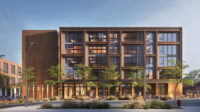Design Vanguard 2018: Cherem Arquitectos
Mexico City

Toreo
The waffle slabs in this office building are suspended from the perimeter steel structure, resulting in mostly uninterrupted open space and highly flexible floors. From the interior, the architects carved out a skylit void, inserting a sculptural stair.
Photo © Enrique Macias Martinez

El Japonez Oasis
Within a 7,000-square-foot restaurant, the architects have created several smaller distinct environments. One of these is a teppanyaki “tunnel,” a pavilion defined by wood lattice.
Photo © Enrique Macias Martinez

Tevila
For a bath used in Jewish purification rituals, Cherem Arquitectos created an otherworldly interior by enclosing the immersion pools within board-formed concrete and admitting daylight through a hidden skylight.
Photo © Enrique Macias Martinez

House C
A residence in San Miguel de Allende encompasses a number of structures, including a guesthouse. The architects chose to make all the buildings of rammed earth, to give the sprawling complex a human scale
Photo © Enrique Macias Martinez

House C
Photo © Enrique Macias Martinez

Casa Padilla
Photo © Enrique Macias Martinez

El Japonez Oasis
Photo © Enrique Macias Martinez

Templo
Photo © Enrique Macias Martinez

Tevila
Photo © Jaime Navarro

Toreo
Photo © Enrique Macias Martinez










Architects & Firms
One of the first things that will impress anyone reviewing the work of Cherem Arquitectos is its variety in scale and program. The Mexico City–based firm’s portfolio includes single-family residences, hospitality work, places of worship, and office buildings. But a shared goal holds these diverse projects together, explains the 35-year-old founder, Abraham Cherem. He and partner Antonio Aguilar, 38, strive to imbue each new commission with its own magic, he says.

The tools used to create their magic—or what Aguilar calls “music”—are carefully considered materials, well-executed details, and an adept handling of illumination. This combination resulted in the serene atmosphere of a mikvah (a bath for Jewish purification rituals) in Mexico City’s Polanco neighborhood. Here, individual immersion pools are enclosed within buff-colored concrete walls, their board-formed texture revealed by daylight that enters—almost mysteriously—through a hidden skylight.
The architects have developed their space-making skills through close study of buildings they admire, including the work of Louis Kahn, Carlo Scarpa, Peter Zumthor, and Renzo Piano. And they have honed their craft through experience. Cherem started the firm CheremSerrano with a friend, Javier Serrano, in 2003, even before the pair finished architecture school. They began small, with interior renovations, gradually increasing the size and complexity of their projects. Then, in 2011, Serrano was tragically murdered just as their highest-profile project yet—the conversion of a 17th-century mansion in Mexico City’s historic center into a hotel (record, June 2013)—was about to open. “It was a tough time,” says Cherem, “but I decided to continue.” He founded his eponymous firm the next year, with Aguilar joining soon after. Aguilar’s past work experience included nearly 10 years at Serrano Arquitectos y Asociados, the well-established Mexico City firm started by Javier’s father.
Together, Aguilar and Cherem have built an impressive body of work, one that is characterized by constant investigation. One example is a large residential compound in San Miguel de Allende that includes a main house, guest quarters, and a caretaker’s house. They used rammed earth, selecting it, in part, because the resulting layered walls would provide a human scale for the sprawling complex. Similarly, within a 7,000-square-foot Japanese restaurant in Mexico City, they created smaller distinct environments, including a wood-lattice teppanyaki “tunnel.” And for a six-story speculative office building in Naucalpan, they experimented with having a mutually shared space for all tenants, carving out a skylit void and inserting a sculptural, suspended stair that links all the floors.
Among Cherem Arquitectos’ current projects are several houses, including one in Miami, two restaurants, and a boutique hotel for the subsidiary of an international chain. We can only expect that this inventive firm will continue to use materials, details, and light in surprising and captivating ways.
Cherem Arquitectos
FOUNDED: 2012
DESIGN STAFF: 10-12
PRINCIPALS: Abraham Cherem Cherem, Jose Antonio Aguilar Garcia
EDUCATION: Cherem: Universidad Iberoamericana, B.Arch., 2005. Aguilar: Universidad Autonoma Metropolitana, B.Arch., 2001
WORK HISTORY: Cherem: CheremSerrano 2003–11. Aguilar: Serrano Arquitectos y Asociados, 2001–10; Taller de Arquitectura Mauricio Rocha, 2010–13
KEY COMPLETED PROJECTS: House C, San Miguel de Allende, 2018; Tevila, Mexico City, 2017; Toreo Office Building, Naucalpan, 2017; Synagogue, Huixquilucan, 2016; Guesthouse C, San Miguel de Allende, 2016; El Japonez Oasis Restaurant, Mexico City, 2016; Apartment A, Mexico City, 2015; House P, Huixquilucan, 2013; Apartment S, Mexico City, 2012 (all in Mexico)
KEY CURRENT PROJECTS: House D, Mexico City; Gourmet Market, Mexico City; North Bay House, Miami; 1 Hotel Cabo, Cabo San Lucas; Hotel Curio by Hilton, Zacatecas; El Japonez Artz, Mexico City; El Japonez Interlomas, Huixquilucan (all in Mexico, except North Bay House)














